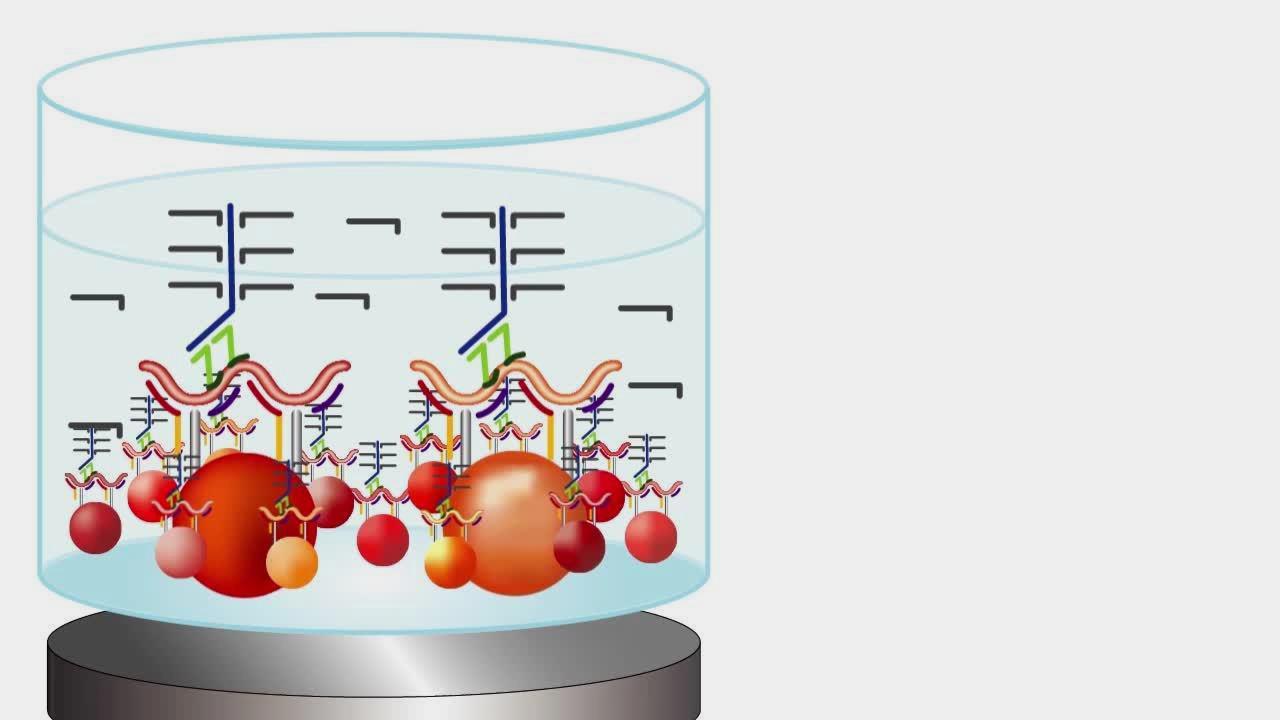Search Thermo Fisher Scientific

xMAP technology
Luminex xMAP (Multi-Analyte Profiling) technology combines advanced fluidics, optics, and digital signal processing with proprietary microsphere technology to deliver multiplexed assay capabilities. xMAP technology uses fluorescence-labeled microspheres or beads, allowing for the simultaneous capture of up to 80 protein analytes or 80 genes from a single reaction. The Invitrogen QuantiGene Plex and ProcartaPlex assays use xMAP technology to perform a wide range of protein- and nucleic acid-based multiplex assays.
The beads are individually read using one of the four Luminex xMAP instrument platforms—INTELLIFLEX, Luminex 200 (LX200), FLEXMAP 3D, and MAGPIX. These instruments use analyzers based on the principles of fluorescent flow cytometry or quantitative fluorescent microscopy and are designed to help meet the needs of any research laboratory size.
Protein detection with ProcartaPlex assays on the Luminex platform
ProcartaPlex multiplex immunoassays are bead-based assays for protein quantification based on the principles of a sandwich ELISA with the use of Luminex xMAP technology. ProcartaPlex assays are available for use with serum, plasma, cell and tissue lysates, cell culture supernatants, and may be suitable for other bodily fluids. Assays are provided in multiple formats including 96- and 384-well, across six species: human, mouse, rat, nonhuman primate, porcine, and canine.
Preconfigured and custom panels are available for every stage in your research from discovery to specific screening. Bead sets are also available as Simplex Kits for single analytes to maintain consistency across panels.
Multiplex gene and protein analysis on one platform
The Luminex platform allows researchers to combine quantitative protein and gene expression workflows without compromising quality or sensitivity. Invitrogen ProcartaPlex and Invitrogen QuantiGene Plex assays enable a unique high-throughput multiomics approach utilizing the Luminex instrument platform. Luminex instruments are an established family of instruments designed for the quantification of multiple analytes from a single low-volume sample using xMAP technology. QuantiGene Plex and ProcartaPlex assays allow for the measurement of up to 80 RNA or protein targets, respectively. Both assay platforms offer pre-defined and custom assays. Find out how to build a custom assay using our new panel configurator tools for QuantiGene Plex and ProcartaPlex assays.
Gene expression with QuantiGene Plex assays on the Luminex platform
The Luminex instrument and bead platform is also useful for the study of gene expression when used with QuantiGene Plex assays. The QuantiGene Plex assay is hybridization-based and incorporates branched DNA (bDNA) technology, which uses signal amplification rather than target amplification for direct measurement of RNA transcripts. The assay is extremely easy to use with a simple ELISA-like workflow.
QuantiGene Plex assays are compatible with many difficult sample types including degraded and cross-linked RNA in FFPE tissues and blood. There is no RNA purification required, preserving precious samples. Up to 80 genes can be screened in the same well of a 96- or 384-well plate maximizing data output.
Luminex instrument features
Fluidics system of the Luminex instrument
The Luminex system interrogates individual beads by flow cytometry. The fluidics system of the reader aligns the beads into single file as they enter a stream of sheath fluid and then enter a flow cell. Once the beads are in single file within the flow cell, each bead is individually interrogated for bead color (analyte) and assay signal strength (PE fluorescence intensity). This established technology helps ensure that all the data is captured.
Lasers for high-sensitivity detection
Lasers have the sensitivity to detect very small quantities of analytes. The reader uses a 532 nm green laser ("assay" laser) to excite the PE dye of the assay (streptavidin-PE). The 635 nm solid state laser (red "classify" laser) is used to excite the dyes inside the beads to determine their "color" or "region" and is also used for doublet discrimination by light scatter. The xMAP INTELLIFLEX DR-SE System features an additional violet (405 nm) reporter laser and is capable of measuring up to two parameters per bead region.
Detectors
The readers have several detectors, one for each of the optical paths. Detectors are used to measure the fluorescence of the assay, to make bead determination (1–500), and to discriminate between single and aggregate beads. Results are collected on a computer.
High throughput
ProcartaPlex and QuantiGene Plex assays designed for 384-well plates combined with the capabilities of xMAP INTELLIFLEX and FLEXMAP 3D Systems to read those plates help enable high-throughput applications. Measure up to 65 to 80 proteins or genes in a single well to gain complete data sets over many samples. Study entire pathways within one well and obtain rich data sets when screening compounds, measuring immune responses, and more.
For Research Use Only. Not for use in diagnostic procedures.
